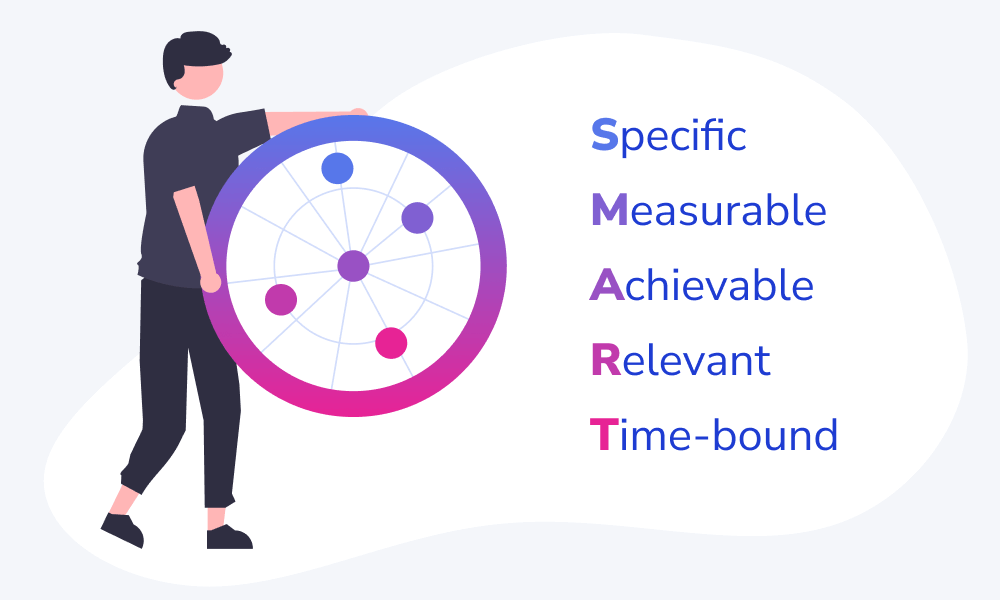Setting realistic and achievable sales targets is a challenge that many sales leaders grapple with in today's competitive market landscape. Striking the right balance between motivating your team to reach for the stars and ensuring those stars aren't out of reach is crucial for sustained growth and morale.
As the demands of the modern sales environment continue to evolve, leaders must ensure that their targets are rooted in strategy, data, and a keen understanding of both the market and their team's capabilities.
This comprehensive guide is designed to help you as a sales leader navigate through the nuances of crafting targets that are not only ambitious but also rooted in realism and data-driven insight.
What you’ll learn here:
The Power and Necessity of SMART Goals in Sales
Setting generic or vague targets is akin to navigating uncharted waters without a compass; you might move forward, but there's no guarantee it's the right direction.
This is where SMART goals come into play, acting as the north star for sales teams worldwide. If you're unfamiliar with the acronym, SMART stands for Specific, Measurable, Achievable, Relevant, and Time-bound.

Each component is meticulously designed to ensure clarity, feasibility, and a tangible roadmap to success:
-
Specificity in goals eliminates ambiguity. Instead of aiming to "increase sales," a SMART goal would dictate a clear number or percentage increase.
-
Measurability ensures you have a yardstick to evaluate progress, a tool to motivate, and a metric to pivot your strategy if needed.
-
Achievability, while promoting ambition, ensures your team isn’t demotivated by impossible benchmarks.
-
Relevance ensures that the goals align with the broader company vision and market strategy.
-
Lastly, being Time-bound gives a clear timeframe, ensuring sustained momentum and a sense of urgency.
And if SMART goals in sales sound familiar, it's likely because of our previous deep dive into 'Setting SMART Sales Enablement Goals: A Step-by-Step Guide'. There, we explored how to weave SMART goals into a sales enablement strategy, creating a cohesive system of not just setting but also equipping your team to meet those goals.
Here, we're expanding on that foundation, emphasizing the indispensable role SMART goals play in crafting a robust and result-driven sales strategy.
In a nutshell, SMART goals aren't just a good idea; they're a necessity for any sales leader looking to lead their team to victory.
The 4 Pillars of Realistic Sales Targets
Diving deeper into the anatomy of successful sales target setting, it becomes evident that several foundational pillars support the entire structure.
Understanding these pillars is not just crucial; it's the very essence of achieving a balanced approach to realistic sales targeting.
Here are the fundamental building blocks:
1. Understanding Market Trends
In today's rapidly evolving marketplace, staying updated with industry trends is more than just a competitive advantage—it's a necessity. As a sales leader, you must have their finger on the pulse of market dynamics. Sites like Statista or industry-specific publications can offer insights into emerging patterns, consumer behaviors, and potential disruptors.
2. Past Sales Data Analysis
Harnessing the power of historical sales data is akin to possessing a crystal ball. By meticulously analyzing this data, you can identify seasonal trends, pinpoint successful strategies, and even forecast potential challenges. Platforms such as Tableau or Showell Analytics provide visualization and analytical capabilities that can turn raw data into actionable insights.
|
📈 See how your buyers consume and engage with your content. Gather customer data, content data, and sales involvement data seamlessly with Showell Analytics. |
3. Growth Expectations
Every company has its eyes set on growth. Aligning sales targets with the broader business growth objectives ensures cohesion between different departments and ensures that everyone is rowing in the same direction.
Regular sync-ups with your executives or using tools like OKRs (Objectives and Key Results) can help in ensuring alignment.
4. Resource Assessment
It's not just about the destination; it's also about understanding the strength and capacity of the vehicle that will get you there.
Before setting targets, it's pivotal to assess the size, skill set, and experience of your sales team. Regular training sessions, feedback loops, and talent acquisition should be in place to bridge any gaps that might exist.
By understanding and integrating these pillars, you can build targets that are not only aspirational but also grounded in the realities of the market and their organization's capabilities.
A Step-By-Step Guide to Setting Sales Targets
Alright, sales leaders, let's roll up those sleeves and dive straight into the nitty-gritty of setting those sales targets.
Think of this process as crafting a fine dish – each ingredient matters, the order in which you add them counts, and the result? A dish (or in this case, a target) that's both appetizing and achievable.

Step 1: Analyzing Historical Sales Data
Before you start charting the future, take a moment to glance back. What were the peaks and troughs last year? Were there any surprises, positive or negative? Tools like CRM software can be a treasure trove of data, giving you patterns that can guide your future strategy.
Remember, understanding where you've been can provide valuable insights into where you should head.
Step 2: Assessing the Sales Funnel and Conversion Rates
Much like checking the consistency of a sauce while cooking, dive into your sales funnel metrics. How many leads are entering the top, and at what rate are they converting? This not only gives you an idea about the quantity but also the quality of your leads. It might be time to simmer or turn up the heat in some areas.
Step 3: Evaluating the Sales Team's Capacity
Now, consider your chefs in this grand kitchen – your sales team. Are they overloaded or underutilized? Assess their current workload, their strengths, areas of improvement, and how they align with the targets you have in mind. There's no point in setting a five-course meal target if you've only got the resources for three.
Step 4: Factoring in External Market Influences
The external market is akin to the unpredictable weather; you might have everything prepped in your kitchen, but if there's a sudden downpour (or a market downturn), it can affect the outcome. Stay informed on market shifts, competitor movements, or any legislative changes that could impact your industry.
Step 5: Refining with SMART Criteria
Lastly, once you have the blueprint, it's time to refine it. Using the SMART (Specific, Measurable, Achievable, Relevant, Time-bound) criteria ensures your targets aren't just numbers but are strategically thought out and aligned with broader organizational goals.
To encapsulate, setting sales targets is part art, part science. The key lies in blending the past's insights with the present's realities and the future's aspirations.
Achieving Sales Targets with the OKR Framework
Utilizing the Objective and Key Results (OKRs) framework can significantly aid in executing and achieving your sales targets. By setting clear objectives coupled with measurable key results, OKRs provide a structured, actionable pathway towards realizing your sales goals.
They promote a culture of tracking progress, fostering accountability, and ensuring alignment across your sales team. The systematic approach of OKRs facilitates a focused effort towards meeting sales targets, ultimately driving success. For a better understanding on leading sales with OKRs, explore this Lead Sales with OKRs insightful blog post by Sellai.
Elevating Your Strategy with Sales Enablement
Okay, let's shift gears for a moment. You've got your sales targets refined, your strategies are taking shape, but what about the fuel to propel your team towards those targets?
That's where sales enablement enters the scene. Think of it as the high-octane fuel needed for the smooth running of a high-performance vehicle – your sales team.
What is Sales Enablement?
In simple terms, sales enablement is all about equipping your sales team with the right tools, resources, and knowledge to succeed. It's the behind-the-scenes magic that empowers them to sell efficiently, engage meaningfully with prospects, and ultimately, close more deals.
Empowering Sales With the Right Tools and Resources
Remember the joy of using a brand new, sharp knife in the kitchen? That's the kind of efficiency we're talking about when you arm your sales team with the latest tools. CRM systems like Salesforce or HubSpot help manage relationships and data.
Platforms for sales analytics can offer insights on performance, while training platforms can sharpen skills. Ensure your team isn't working with blunt tools; give them the best to get the best results.
Continuous Training and Development
Speaking of sharpening, continuous learning is crucial. The sales landscape is ever-evolving. What worked yesterday might not work today. Regular training sessions, whether they're about the latest product updates or new sales methodologies, ensure that your team isn't just keeping up but staying ahead of the curve.
|
👍 Every sales leader knows the importance of a well-trained team. But have you ever stopped to consider the ripple effect of what robust training can achieve? Read more and learn How to Create a Sales Training Curriculum. |
The Role of Content in Sales Enablement
Sales enablement isn't just about tools and training. It's also about having the right content at the right time. Be it product sheets, case studies, or even a compelling email template; the right content can make all the difference in engaging a prospect. It's like having the perfect seasoning on hand while cooking; it can elevate a dish immensely.
In essence, while setting ambitious sales targets is crucial, ensuring your team has the arsenal to achieve them is equally vital. Sales enablement isn't an afterthought; it's a cornerstone of a successful sales strategy.
|
📈 As you set your sales enablement strategy and goals, it's important to develop the essential skills you team will need along the way. Read more about 7 Essential Skills Your Team Needs to Achieve Sales Enablement Goals. |
Case Study: Agrifac's Sales Enablement Success with Showell
Agrifac stands as a beacon of innovation in the agricultural machinery sector, specifically in the realm of self-propelled crop sprayers. With their global footprint across Europe, North America, and Australia, they have a mission that resonates with many: addressing the surging global food demand without sacrificing our planet's well-being.
A Deep Dive into Agrifac's Challenge
However, such a groundbreaking approach came with its set of challenges. Agrifac's dealer-centric sales model spanned 35 nations, leading to dispersed sales content and making marketing a challenging endeavor
The traditional reliance on print materials, besides being eco-unfriendly, became costly and cumbersome. They were grappling with content management in different languages and the agility to update product specifics.
The pressing need? A singular platform for their sales force to access real-time, pertinent data while augmenting the quality and efficiency of sales and marketing initiatives.
Enter Showell: The Sales Enablement That Changed the Game
Showell emerged as the knight in shining armor for Agrifac. Acting as a unified repository for all marketing and sales assets, it transformed the way Agrifac's sales teams operated.
Customizable presentations on the fly? Check. Swift content sharing? Absolutely. Plus, the on-the-go access meant sales reps could address client queries during meetings seamlessly.
Renate Houtman, Agrifac's Senior Online Marketer, aptly encapsulates the sentiment:
"Showell helps us make sure that everyone gets the information and can use it effectively in sales when preparing or engaging customers."
One standout feature? Showell's robust analytics. It allowed Agrifac's top brass to gauge sales activity, making sure no member of the team was left behind. Plus, the platform bolstered their internal training programs, embedding a spirit of perpetual learning.

Reaping the Benefits: Showell and Agrifac's Partnership
The outcomes of this collaboration were nothing short of stellar. Showell didn't just streamline processes; it reinvented them. Agrifac witnessed a significant uptick in overall efficacy and professionalism in sales.
- Strategic Focus: The centralization meant fewer mundane queries for the marketing teams, granting them more bandwidth for higher-order strategic initiatives.
-
Sales Optimization: The ability for sales reps to assess content impact ensured a more tailored client approach.
-
Brand Enhancement: Showell, with its premium aura, gave a boost to Agrifac's already sterling brand reputation. The figures speak for themselves – an annual growth rate soaring between 25-30%.
-
Green Goals: In a bid to be more eco-conscious, Showell slashed Agrifac's print dependencies, leading to monetary and environmental savings.
The Agrifac-Showell alliance stands as a testament to how sales enablement tools can catalyze growth, reinforce training, and drive organizational efficiency. For sales leaders worldwide, it's a case study that underlines the essence of adapting to digital transformations in sales.
|
🚀 Read more about Agrifac's Customer Success Story: How Showell Plays a Significant Role in Agrifac's Global Growth? |
In conclusion, setting realistic and achievable sales targets isn't just a strategic imperative—it's the foundation on which long-term growth and success are built.
From the power of SMART goals to the undeniable benefits of sales enablement tools like Showell, a methodical approach fused with modern technology makes all the difference.
As sales leaders, it's crucial to remain adaptable, draw insights from data, and harness the potential of sales enablement strategies. Ready to propel your sales strategies into the future? Book a demo with us by clicking the banner below and witness firsthand how it can optimize your sales journey.
💡 Learn next:




.png?width=795&height=318&name=Blog%20banner_%20Get%20Showell%20Free%20(1).png)
